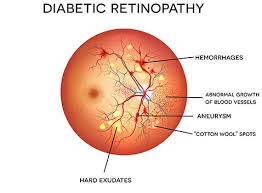 Diabetic retinopathy is a diabetes complication that affects eyes.
Diabetic retinopathy is a diabetes complication that affects eyes.
It is caused by damage to the blood vessels of the light-sensitive tissue at the back of the eye (retina).
At first, diabetic retinopathy might cause no symptoms or only mild vision problems, but it can lead to blindness.
The condition can develop in anyone who has type 1 or type 2 diabetes.
The longer one has diabetes and the less controlled the blood sugar, the more likely to develop this eye complication.
Its symptoms include:
Spots or dark strings floating in your vision (floaters)
Blurred vision
Fluctuating vision
Dark or empty areas in vision
Vision loss
Developing diabetes when pregnant (gestational diabetes) or having diabetes before becoming pregnant can increase risk of diabetic retinopathy.
There are two types of diabetic retinopathy:
Early diabetic retinopathy. called nonproliferative diabetic retinopathy (NPDR) — new blood vessels aren’t proliferating.
With NPDR, the walls of the blood vessels in the retina weaken, and tiny bulges protrude from the walls of the smaller vessels,sometimes leaking fluid and blood into the retina.
Larger retinal vessels can begin to dilate and become irregular in diameter as well.
NPDR can progress from mild to severe as more blood vessels become blocked.
Retinal blood vessel damage can lead to a buildup of fluid (edema) in the center portion (macula) of the retina.
If macular edema decreases vision, treatment is required to prevent permanent vision loss.
Advanced diabetic retinopathy.
Diabetic retinopathy can progress to this more severe type, known as proliferative diabetic retinopathy.
In this type, damaged blood vessels close off, causing the growth of new, abnormal blood vessels in the retina.
These new blood vessels are fragile and can leak into the clear, jellylike substance that fills the vitreous.
Eventually, scar tissue from the growth of new blood vesselscan cause the retina to detach from the back of the eye.
If the new blood vessels interfere with the normal flow of fluid out of the eye, pressure can build in the eyeball.
This buildup can damage the optic nerve, resulting in glaucoma.
Risk factors
Anyone who has diabetes can develop diabetic retinopathy.
Prolonged and poorly controlled diabetes
High blood pressure
High cholesterol
Pregnancy
Tobacco use
Being Black, Hispanic or Native American
Complications
Vitreous hemorrhage.
Retinal detachment.
Glaucoma.
Blindness.
Prevention
Diabetic control
Smoking cessation
Among patients with NPDR but without center involved diabetic macular edema at four years treatment with IV aflibercept versus versus compared to initiating aflibercept treatment only if vision threatening complications developed, resulted in significant anatomic improvement, but no improvement in visual acuity at four years.
